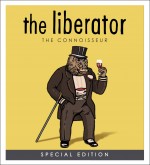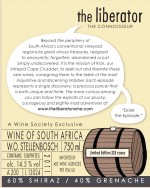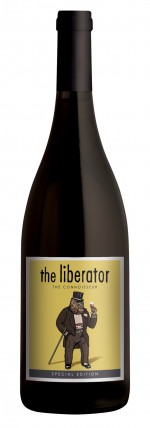Exclusive to members of The Wine Society
The Connoisseur
Technical Information:
| Producer: | Zevenwacht |
| The Wine: | 60% Syrah 40% Grenache |
| Vintage: | 2011 |
| Wine of Origin: | Stellenbosch |
| Alcohol: | 14.5% |
| Bottles: | 3,900 bottles |
Over the years, Rick has had several close encounters with troops of baboons; whether it be in the vineyards where they are to be found raiding the vines; or on the beach helping themselves to husks of sweetcorn off the braai; or even foraging (read competing) for porcini in the Jonkershoek forest, close to Stellenbosch.
 Indeed, the Cape baboon inhabits a wide array of habitats, including woodland, savannah and the semi-desert environment of the Karoo. At night, barking baboons can be heard as they prepare to roost on cliff-faces or in large trees.
Indeed, the Cape baboon inhabits a wide array of habitats, including woodland, savannah and the semi-desert environment of the Karoo. At night, barking baboons can be heard as they prepare to roost on cliff-faces or in large trees.
Omnivorous, with a preference for all types of fruits (and not only grapes), their diet also includes insects, seeds, grass and even smaller vertebrate animals; the baboon is essentially a scavenger that will eat most of what it finds in its path. But that’s not to say this pesky primate is not selective either. Rick can readily cite examples of baboons exhibiting preference for certain grape varieties over others. At Cape Chamonix in Franschhoek, the local troop just loves Gottfried Mocke’s carefully tended Pinot Noir, whilst they can’t be bothered to venture into the neighbouring Merlot vineyard. Down in Agulhas, the baboons there have developed methods to breach the electric fences (which primarily involves pushing their fellow primates into the wires to short-circuit the system) before raiding Quoin Rock’s Sauvignon Blanc vines. Rick can recall a whole vintage being lost over the course of a weekend… Clearly sufferers of ‘ABC syndrome’ (Anything But Chardonnay), the adjoining vineyard remained untouched.
 So, just how do wine farmers in the Cape combat the presence of these gastronomic monkeys? Here are a few options on how to baffle a baboon… Described to Rick as his ‘baboon belt’, one farmer in Tulbagh has planted Alicante Brouchet around the perimeter of his vineyard. As a teinturier variety (one that has red flesh as well as skins), the baboons are fooled into thinking they have blood on their hands and they tend to depart (usually to the neighbouring farm) instead. Also in Tulbagh, one particularly clever vigneron has gone as far as collecting lion dung from Cape Town’s Tygerberg zoo and mixing it with water to make a sort of poo-porridge which is then scattered around the entrance to the vineyards. Scared by the prospect of being taken-out by their most feared predator, the baboons tend to turn and head for the hills… Other methods include the firing of cannons (obviously not directly at the baboons), the blowing of vuvazelas (the ‘musical’ instrument indiscriminately blown at South African football matches), the strategic positioning of rubber snakes, or even the employment of the local ADT security firm immediately before harvest. All have all been legitimately used to protect the grape growers’ precious crop.
So, just how do wine farmers in the Cape combat the presence of these gastronomic monkeys? Here are a few options on how to baffle a baboon… Described to Rick as his ‘baboon belt’, one farmer in Tulbagh has planted Alicante Brouchet around the perimeter of his vineyard. As a teinturier variety (one that has red flesh as well as skins), the baboons are fooled into thinking they have blood on their hands and they tend to depart (usually to the neighbouring farm) instead. Also in Tulbagh, one particularly clever vigneron has gone as far as collecting lion dung from Cape Town’s Tygerberg zoo and mixing it with water to make a sort of poo-porridge which is then scattered around the entrance to the vineyards. Scared by the prospect of being taken-out by their most feared predator, the baboons tend to turn and head for the hills… Other methods include the firing of cannons (obviously not directly at the baboons), the blowing of vuvazelas (the ‘musical’ instrument indiscriminately blown at South African football matches), the strategic positioning of rubber snakes, or even the employment of the local ADT security firm immediately before harvest. All have all been legitimately used to protect the grape growers’ precious crop.
Afrikaans Lesson #381:
Lekker – Afrikaans (and Dutch) for tasty or nice and used as a punctuation by South African’s of any language group to describe everything that might be considered marginally above mediocre. It equates to the use of the Welsh interpretation of the word lush… Its common usage extends further and is often heard when bidding someone a good night – as with Lekker slaap (sleep well).
Afrikaans Lesson #125:
Bobbejaan – Better known to the English speaking world as the (chacma) baboon.
Afrikaans Lesson #257:
Babalas – Most often heard recited the morning after the night before: ‘ell boet, I’ve got a moerse babalas…’ which best translates as: ‘Hell buddy, I’ve got a massive hangover…’




